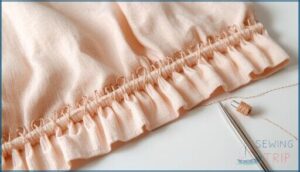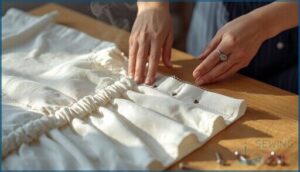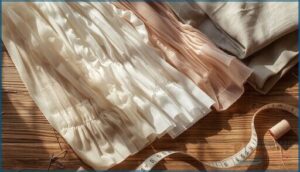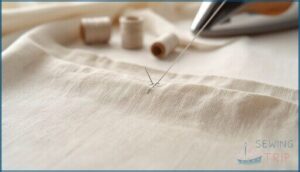This site is supported by our readers. We may earn a commission, at no cost to you, if you purchase through links.
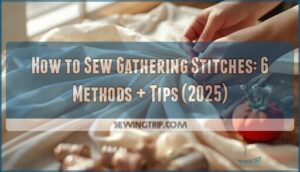
You’ve basted the seams, set up your machine, and pulled those bobbin threads with confidence—only to watch your fabric bunch into a stubborn mess instead of soft, even gathers. Gathering stitches look deceptively simple, but the difference between lumpy chaos and elegant ruffles comes down to technique.
The right stitch length, thread tension, and pulling method transform a basic running stitch into professional-looking fullness that lies flat and distributes beautifully. Whether you’re adding volume to a sleeve cap, creating a tiered skirt, or shaping a bodice, mastering this foundational skill unlocks dozens of garment possibilities.
Six proven methods exist for gathering fabric, each suited to different weights, textures, and project requirements.
Table Of Contents
- Key Takeaways
- Gathering Fabric: a Step-by-Step Guide
- Preparing for Gathering
- Techniques for Gathering Fabric
- Securing The Gathers
- Finishing The Gathered Seam
- 6 Methods for Gathering Fabric
- Tips for Achieving The Best Gathering Stitch
- Sewing Without Visible Stitches: Tips and Tricks
- Frequently Asked Questions (FAQs)
- Conclusion
Key Takeaways
- Successful gathering requires two parallel rows of long stitches (4-5mm) sewn within the seam allowance, with loosened thread tension and gentle pulling of bobbin threads to create even, controlled fullness.
- Fabric weight determines your gathering approach—lightweight cottons work beautifully at 2:1 ratios with standard techniques, while heavier fabrics need 1.5:1 ratios and specialized methods like zigzag-over-cord to prevent thread breakage.
- Six proven gathering methods exist (machine gathering, three-row gathering, hand gathering, serger gathering, cord gathering, and two-thread gathering), each offering different levels of speed and control for specific fabric types and project requirements.
- Professional results depend on proper preparation—prewashing fabric to prevent post-construction shrinkage, testing settings on scraps first, and securing gathers with firm knots before pressing seams away from the folds without crushing them.
Gathering Fabric: a Step-by-Step Guide
Gathering fabric transforms flat cloth into dimensional design—it’s the foundation of ruffles, puffy sleeves, and fitted bodices. You’ll gather by pulling a longer piece of fabric down to a shorter length, creating soft folds that add volume and movement.
Gathering fabric pulls longer cloth into shorter, dimensional folds—the foundation of ruffles, volume, and movement
Before you start, fabric selection matters: lightweight to medium-weight wovens like cotton or lawn gather beautifully at ratios around 2:1, while heavier fabrics need closer to 1.5:1 to avoid bulk. Set your machine to the longest stitch length—about 4–5 mm works for most gathering stitches. Sew two parallel rows within your seam allowance, leaving long thread tails. Pull the bobbin threads gently from both ends to distribute fabric fullness evenly.
These gathering techniques give you control over texture. Master this gathering stitch, and you’ll discover countless fabric gathering methods for every project ahead. Understanding the sewing gathering technique is essential for achieving the desired gathering effect.
Preparing for Gathering
Your machine can create perfect gathers—but only if you lay the groundwork first. Fabric Selection sets the stage: lightweight cottons and voile (around 70–120 g/m²) gather smoothly, while denim above 250 g/m² demands stronger thread and patience. Fabric Prewashing matters, too—untreated cottons can shrink 3–5% after construction, distorting your gathers. Mark your Seam Allowance at ⅝ inch minimum; this gives you room for two parallel Gathering Stitches without crowding the seam line. Set your Stitch Length to 4–5 mm, loosen Thread Tension slightly, and test on scraps before you commit. Understanding gathering techniques is essential for achieving professional results.
Here’s your checklist:
- Prewash fabric at laundering temperature to eliminate post‑construction shrinkage
- Mark seam allowance clearly with tailor’s chalk or washable pen
- Select all‑purpose thread and adjust tension looser than normal seam settings
- Test Gathering Techniques on a 10‑inch scrap to dial in stitch length and Gathering Tools performance
Techniques for Gathering Fabric
Gathering fabric doesn’t have to be complicated when you know the right techniques. Each method gives you a different level of control and works better for specific fabrics or project types.
Let’s look at three reliable gathering techniques you can start using right away.
Two Thread Gathering
Two rows of basting stitches give you the control and reliability that single-row gathering can’t match. Set your stitch length between 4–5 mm and sew two parallel lines within your seam allowance—usually 1/4 inch and 1/2 inch from the raw edge. Don’t backstitch; you’ll need those thread tails free to pull.
| Step | Stitch Length | Thread Tension |
|---|---|---|
| Sew first row | 4–5 mm | Moderate or slightly loose |
| Sew second row | 4–5 mm | Same as first |
| Pull bobbin threads | N/A | N/A |
| Distribute gathers | N/A | N/A |
| Pin and stitch permanently | 2.5 mm | Normal |
Gently pull both bobbin threads from one end while the fabric slides along, then distribute the gathers evenly before pinning.
Three Thread Basting
When you need that perfect, professional-looking gather—especially on heavier fabrics or structured garments—three parallel rows of basting stitches deliver superior control. Position one row at your seam line, then add two more spaced roughly 1/8 inch apart within your seam allowance. Set your stitch length to 4–5 mm and sew all three rows without backstitching, leaving long thread tails.
Pull the bobbin threads gently from both ends, watching the fabric slide into smooth, even folds. The triple-row setup distributes tension across multiple threads, reducing breakage and keeping gathers aligned beautifully. Pin carefully, then sew your permanent seam between the second and third rows. Remove the outer basting threads afterward—your gathers won’t budge.
Zig Zag Over a Cord
When standard gathering techniques fail on heavy canvas or slippery satin, zigzagging over a cord becomes your secret weapon. Cut sturdy yarn or heavy thread several inches longer than your fabric edge, then position it inside your seam allowance about 1 cm from the edge.
Set your sewing machine zigzag settings to 2.5–3.5 mm width and 1.5–2.5 mm length—wide enough to straddle, never pierce, the cord. Stitch carefully along the entire edge, keeping the cord free inside its zigzag casing.
Pull the cord ends like a drawstring, and watch your fabric gather smoothly without thread breakage. This gathering technique offers exceptional gather control for challenging fabric choices, delivering professional stitch quality every time.
Securing The Gathers
Precision in thread security transforms gathered fabric from temporary to permanent. Once you’ve pulled your gathers to the desired fullness, lock both bobbin and needle threads with a firm double or triple knot positioned within the seam allowance—this gather locking step prevents unraveling during handling. Wrap thread tails around pins in a figure-eight pattern at each end for additional stability, especially when working with slippery fabrics.
For stitch reinforcement, adjust your thread tension to a mid-range setting (around “4” on most machines) to avoid breakage when tightening gathers. Use high-quality thread matched to your fabric weight—this simple change prevents snapping during the securing process.
Fabric stabilization comes next: sew a temporary staystitch 3–4 mm inside the seam allowance over your adjusted gathers. This extra line holds fullness steady before you attach the gathered piece to your flat fabric, maintaining even distribution throughout construction.
Finishing The Gathered Seam
A polished gathered seam hinges on careful bulk management and strategic edge finishing. After stitching your gathering stitches and joining the gathered fabric to the flat piece, trim the seam allowance to approximately 6–7 mm—this reduces thickness without compromising strength. Keep the flat fabric’s allowance untrimmed for stability.
Next, tackle fray prevention. Run a zigzag stitch along the raw edge, serge both layers together, or encase them in bias binding for a couture touch. Your seam finishing method depends on fabric weight and garment purpose.
Now for pressing techniques: lay the seam flat first, then press the allowance away from the gathers using only your iron’s tip. Avoid crushing those beautiful folds you worked so hard to create. Finally, remove visible basting threads once everything’s secure—this simple step elevates your fabric gathering from homemade to handcrafted excellence.
6 Methods for Gathering Fabric
You’ve got plenty of options for gathering fabric, and each method has its own strengths depending on your project and preferences. Some techniques work faster, while others give you more control over the final look.
Let’s walk through six reliable methods you can use to create beautiful, even gathers every time.
Machine Gathering
Machine gathering transforms fabric manipulation into an efficient process when you understand your sewing machine settings. Set your stitch length to 4–5 mm—roughly double the standard construction setting—and reduce thread tension slightly below the default level 4 to prevent breakage.
Sew two parallel rows approximately 3–6 mm from the fabric edge, leaving long thread tails unsecured. Pull the bobbin threads gently to draw up even gathering stitches, sliding the fabric along in small sections for consistent fullness across your seam.
Three Rows Gathering
Three rows of gathering stitches deliver the gather control professional sewers crave when working with visible design elements. Set your stitch length to 4–5 mm and sew parallel rows roughly 1 cm, 1.3 cm, and 1.6 cm from the fabric edge, leaving long thread tails at both ends.
This gathering technique spreads fullness more evenly than two-row methods, particularly on medium-weight cottons and linens. Pull all bobbin threads simultaneously while sliding the fabric along—the extra row prevents thread breakage and maintains consistent density.
When you sew your permanent seam between the second and third rows, you’ll lock those beautifully uniform gathers in place without visible basting threads showing.
Hand Gathering
Hand stitching gives you superior fabric control when gathering delicate materials like lawn, voile, or fine silk—fabrics that have graced historical garments for centuries. Thread your needle with strong thread (waxed for less tangling), then work one or two parallel rows of long running stitches along your seamline, leaving generous thread tails at both ends. This gathering technique lets you adjust fullness precisely by sliding fabric along the threads.
For lightweight fabrics, take stitches through 6–7 threads; sturdier cottons need roughly double that. Stroke gathers—where you straighten and fold fabric into parallel ridges—or whipped gathers for fine ruffles represent time-tested sewing techniques. Hand sewing gathering stitches demands patience but rewards you with outstanding gathering tools-free control.
Serger Gathering
When hand methods feel too slow, your serger becomes a secret weapon for gathering stitch work. Set your differential feed to 2.0 (the highest on most machines) and crank stitch length to 4 mm—this creates the feed ratio needed to gather fabric efficiently. A 4-thread configuration gives structural strength while trimming, seaming, and finishing edges in one pass. If gathers look too loose, increase needle tension gradually; test strips prevent guesswork and reveal how your fabric ratios behave under specific serger settings.
A gathering foot attachment lets you join a flat layer to a ruffled one simultaneously, often achieving ratios like 1.5:1. Lightweight cottons respond beautifully to these sewing machine settings, though heavier textiles may need adjustments. This gathering technique isn’t just fast—it’s your express lane to professional, durable seams that won’t unravel under stress.
Cord Gathering
When serger speed isn’t enough for heavy fabrics, cord gathering offers bulletproof control. Thread a sturdy cord—perle cotton or lightweight cording works best—under your presser foot and set your sewing machine to a zigzag stitch width of 2.5–6.0 mm.
The key? Straddle the cord without piercing it; stitching through stops the gathering action cold. Position your gathering stitches about 1 cm from the raw edge, then pull one cord end like a drawstring to compress the fabric.
Cord tension determines your gathering speed and fabric control—tighten gradually until your gathered fabric matches the target length. This gathering technique prevents thread breakage on long ruffles, letting you sew gathering lines that won’t snap under pressure.
Tips for Achieving The Best Gathering Stitch
Perfecting your gathering stitches comes down to mastering a few key elements that work together like a well-tuned engine. Start with stitch length control—set your machine to 4–5 mm for smooth, manageable gathers. Pair that with slightly loosened thread tension (around 3–4) so your threads pull without snapping. This combination gives you the gathering ratio you’re after while keeping your seam finishing clean.
Your fabric selection matters more than you’d think. Lightweight cottons respond beautifully to standard gathering techniques, but heavier materials need longer stitches and stronger thread to handle the extra bulk.
Here’s what locks in consistent results:
- Sew two parallel rows within your seam allowance for stability and backup
- Pull gently from the bobbin side—never yank
- Mark quarter points on both pieces before gathering
- Test your gathering stitch setup on scraps first
- Leave long thread tails for easier adjustment
Master these basics, and you’ll handle any gathering project with confidence.
Sewing Without Visible Stitches: Tips and Tricks
Once you’ve nailed your gathering stitches, mastering invisible finishing techniques opens up new territory. Blind stitching keeps hems subtle by catching only a few fabric threads per stitch, while fusible hems offer adhesive finishes that eliminate visible thread lines entirely. For truly smooth bonding, try heat-activated films that join layers without needle marks.
When working with gathers, you’ll want to adjust thread tension and sew gathering rows within your seam allowance. These sewing techniques for beginners transform projects from homemade to professional:
- Match thread color precisely to your fabric
- Position stitches inside folds or along seam lines
- Test invisible hemming methods on scraps first
Frequently Asked Questions (FAQs)
How to do a gathering stitch on a sewing machine?
Picture billowy skirts taking shape under your hands. Dial your sewing machine to its longest stitch length—around 4 to 5 millimeters—then sew two parallel rows inside your seam allowance. Pull the bobbin threads gently to create soft, controlled gathers.
What is the best stitch for gathering?
The best gathering stitch is a long straight basting stitch set to your machine’s longest stitch length, usually 4–5 mm. Two parallel rows spaced ¼ inch apart create adjustable, even gathers.
What are the settings for gathering stitches?
Imagine your machine as a precision instrument: set stitch length to maximum (0–0 mm), increase thread tension near the upper limit, and adjust presser foot pressure.
These gathering stitch settings control your gathering ratio perfectly.
What tension is needed for gathering stitch?
For gathering stitch, set thread tension slightly below your machine’s balanced range—around 2–4—so bobbin threads pull smoothly without breaking.
Adjust tension settings based on fabric thickness and your preferred gathering ratio for controlled, even results.
How do I fix uneven gathering stitches?
Why do your gathers bunch unevenly? Redistribute fullness by gently tugging bobbin threads, then smooth fabric with your fingers.
Mark quarter-sections before stitching and adjust thread tension control to prevent clustering along waistbands or cuffs.
Can I gather stretchy fabrics without elastic?
Yes, you can gather knit fabrics using cord gathering or serger techniques instead of elastic. Set your machine to 0–0 mm stitches, sew two rows, then pull bobbin threads carefully to create controlled gathers on stretch fabric.
What’s the best thread for dense gathers?
For dense gathers, reach for polyester all-purpose thread—it won’t snap under tension and keeps your ruffles intact. Fine polyester works beautifully on lightweight fabrics, strong corespun on heavier ones.
How do I prevent thread from breaking?
Polyester all-purpose thread delivers roughly 900–1,200 cN tensile strength—far stronger than cotton.
Loosen tension control slightly, select a larger needle, extend stitch length to 4–5 mm, pull bobbin threads gently, and always test on scraps first.
Can I gather fabric with decorative stitches?
Zigzag-over-cord works well for structural gathering, but most decorative stitches add bulk and friction that prevent smooth fabric slippage.
Use simple gathering stitches first, then apply decorative sewing embellishments over finished gathers for controlled results.
What fabrics work best for gathering stitches?
Lightweight wovens like cotton lawn and voile are your best friends for gathering stitches—they drape beautifully and create soft, even gathers.
Medium-weight fabrics work too, but require adjusted thread tension for smooth fabric manipulation.
Conclusion
Think of gathering stitches as your bridge between flat fabric and dimensional design—each pull transforms potential into shape. You’ve now explored six distinct methods, from machine efficiency to hand-stitched control, each opening new creative territory.
The thread you choose, the tension you set, and how you sew gathering stitches determine whether your project whispers elegance or shouts amateur hour. Master these techniques, and you’ll never view a ruffle, puff, or gathered seam the same way again.



